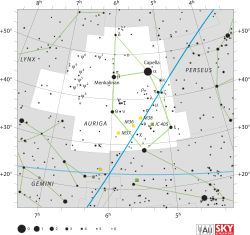V538 Aurigae
V538 Aurigae är en ensam stjärna[10] i norra delen av stjärnbilden Kusken. Den har en skenbar magnitud av ca 6,25[2] och är mycket svagt synlig för blotta ögat där ljusföroreningar ej förekommer. Baserat på parallax enligt Gaia Data Release 2 på ca 81,4 mas,[1] beräknas den befinna sig på ett avstånd på ca 40 ljusår (ca 12 parsek) från solen. Den rör sig bort från solen med en heliocentrisk radialhastighet på ca 1 km/s.[5] Stjärnan ingår i den lokala bubblan[3] och omges troligen av en tunn skiva.[5]
| V538 Aurigae | |
 | |
| Observationsdata Epok: J2000.0 | |
|---|---|
| Stjärnbild | Kusken |
| Rektascension | 05t 41m 20,33573 s[1] |
| Deklination | +53° 28′ 51,8106 ″[1] |
| Skenbar magnitud () | 6,25[2] |
| Stjärntyp | |
| Spektraltyp | K1 V[3] |
| U–B | +0,50[2] |
| B–V | +0,84[2] |
| Variabeltyp | BY Draconis-variabel[4] |
| Astrometri | |
| Radialhastighet () | +0,9[5] km/s |
| Egenrörelse (µ) | RA: +2,784[1] mas/år Dek.: -523,602[1] mas/år |
| Parallax () | 81,4300 ± 0,0487[1] |
| Avstånd | 40,05 ± 0,02 lå |
| Absolut magnitud () | +5,75[6] |
| Detaljer | |
| Massa | 0,871[5] M☉ |
| Radie | 0,82 +0,02−0,03[1] R☉ |
| Luminositet | 0,478 ± 0,001[1] L☉ |
| Temperatur | 5 303 +100−63[1] K |
| Metallicitet | +0,16[7] |
| Vinkelhastighet | 2,80 [4] km/s |
| Ålder | 3,76[5] miljarder år |
| Andra beteckningar | |
| HD 37394, AG+53 486, BD+53 934, CCDM J05413+5329A, GJ 211, GSC 03749-01334, HIC 26779, HIP 26779, HR 1925, IRAS 05373+5327, LHS 1774, LSPM J0541+5328, 2MASS J05412033+5328523, NLTT 15439, NSV 16618, PLX 1289, PPM 29972, 2RE J0541+532, 2RE J054119+532931, 1RXS J054122.0+532903, SAO 25319, TYC 3749-1334-1, USNO-B1.0 1434-00163923, uvby98 100037394, V538 Aurigae, WDS J05413+5329A, WISEA J054120.37+532846.5, [GKL99] 145, Gaia DR2 263916708025623680, Gaia DR3 263916708025623680[8][9] | |
Egenskaper redigera
V538 Aurigae är en gul till vit stjärna i huvudserien av spektralklass K1 V.[2] Den har en massa som är ca 0,87[6] solmassor, en radie som är ca 0,82[1] solradier och har ca 0,48 gånger solens utstrålning av energi[1] från dess fotosfär vid en effektiv temperatur av ca 5 300 K.[1]
V538 Aurigae är en BY Draconis-variabel,[4] vilket betyder att den genomgår förändringar i ljusstyrka eftersom områden med uttalad magnetisk ytaktivitet flyttas in i och ut ur siktlinjen från jorden när stjärnan roterar (ungefär en gång per 11 dygn).[7]
Stjärnan har en följeslagare med gemensam egenrörelse betecknad Vys 465 (HD 233153),[13] som är en röd dvärg av spektralklass M0,5 V och med en visuell magnitud på 9,87. Deras projicerade separation är 1 204 AE.[14]
Referenser redigera
- Den här artikeln är helt eller delvis baserad på material från engelskspråkiga Wikipedia, V538 Aurigae, 24 januari 2023..
Noter redigera
- ^ [a b c d e f g h i j k l] Brown, A. G. A.; et al. (Gaia collaboration) (August 2018). "Gaia Data Release 2: Summary of the contents and survey properties". Astronomy & Astrophysics. 616. A1. arXiv:1804.09365. Bibcode:2018A&A...616A...1G. doi:10.1051/0004-6361/201833051. Gaia DR2 record for this source at VizieR.
- ^ [a b c d e] Mermilliod, J.-C. (1986). "Compilation of Eggen's UBV data, transformed to UBV (unpublished)". Catalogue of Eggen's UBV Data. SIMBAD. Bibcode:1986EgUBV........0M.
- ^ [a b] Montes, D.; et al. (November 2001). "Late-type members of young stellar kinematic groups - I. Single stars". Monthly Notices of the Royal Astronomical Society. 328 (1): 45–63. arXiv:astro-ph/0106537. Bibcode:2001MNRAS.328...45M. doi:10.1046/j.1365-8711.2001.04781.x. S2CID 55727428.
- ^ [a b c] Mishenina, T. V.; et al. (November 2012). "Activity and the Li abundances in the FGK dwarfs". Astronomy & Astrophysics. 547: 8. arXiv:1210.6843. Bibcode:2012A&A...547A.106M. doi:10.1051/0004-6361/201118412. S2CID 119287319. A106.
- ^ [a b c d e] Ramírez, I.; et al. (February 2013). "Oxygen abundances in nearby FGK stars and the galactic chemical evolution of the local disk and halo". The Astrophysical Journal. 764 (1): 78. arXiv:1301.1582. Bibcode:2013ApJ...764...78R. doi:10.1088/0004-637X/764/1/78. S2CID 118751608.
- ^ [a b] Holmberg, J.; et al. (July 2009). "The Geneva-Copenhagen survey of the solar neighbourhood. III. Improved distances, ages, and kinematics". Astronomy and Astrophysics. 501 (3): 941–947. arXiv:0811.3982. Bibcode:2009A&A...501..941H. doi:10.1051/0004-6361/200811191. S2CID 118577511.
- ^ [a b] Maldonado, J.; et al. (October 2010). "A spectroscopy study of nearby late-type stars, possible members of stellar kinematic groups". Astronomy and Astrophysics. 521: A12. arXiv:1007.1132. Bibcode:2010A&A...521A..12M. doi:10.1051/0004-6361/201014948. S2CID 119209183.
- ^ HD 37394 (unistra.fr). Hämtad 2023-03-22.
- ^ "HD 37394". SIMBAD. Centre de données astronomiques de Strasbourg. Hämtad 2020-11-08.
- ^ Halbwachs, J. -L; et al. (2018). "Multiplicity among solar-type stars. IV. The CORAVEL radial velocities and the spectroscopic orbits of nearby K dwarfs". Astronomy and Astrophysics. 619: A81. arXiv:1808.04605. Bibcode:2018A&A...619A..81H. doi:10.1051/0004-6361/201833377. S2CID 119437322.
- ^ MAST: Barbara A. Mikulski Archive for Space Telescopes". Space Telescope Science Institute. Hämtad 8 december 2021.
- ^ Gaidos, E. J.; Henry, G. W.; Henry, S. M. (August 2000). "Spectroscopy and Photometry of Nearby Young Solar Analogs". The Astronomical Journal. 120 (2): 1006–1013. Bibcode:2000AJ....120.1006G. doi:10.1086/301488. S2CID 16930014.
- ^ Soderblom, David R.; Clements, Sandra D. (April 1987). "Chromospheric and Transition-Region Emission from Young Solar-Type Stars in Clusters, Kinematic Groups, and the Field". The Astronomical Journal. 93: 920–937. Bibcode:1987AJ.....93..920S. doi:10.1086/114378.
- ^ Halbwachs, J. -L.; et al. (February 2017). "Double stars with wide separations in the AGK3 - II. The wide binaries and the multiple systems*". Monthly Notices of the Royal Astronomical Society. 464 (4): 4966–4976. arXiv:1610.04423. Bibcode:2017MNRAS.464.4966H. doi:10.1093/mnras/stw2683.



